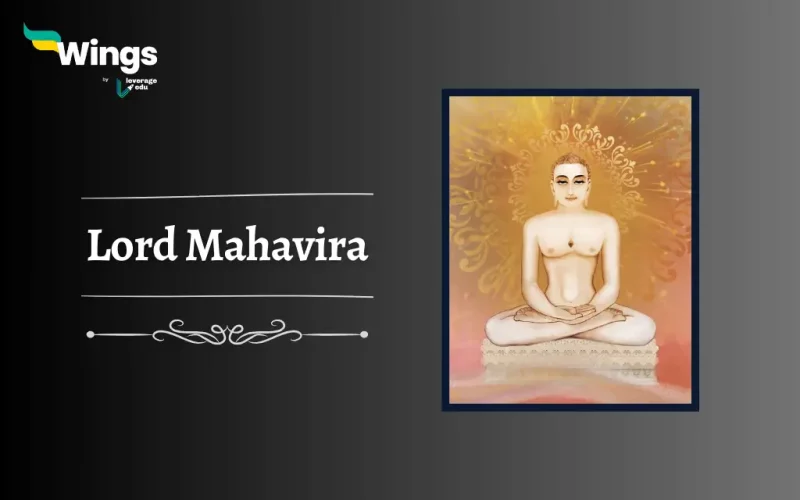Lord Mahavira was known as Vardhaman Mahavira. The meaning of Mahavira is “Great Hero”. Additionally, Lord Mahavira was the 24th Tirthankar of Jainism. He lived in ancient India around the 6th century BCE. Moreover, he was a spiritual leader whose teachings on ahimsa, compassion and self-realization had a life-changing impact on millions of people around the world. In this blog, we will learn more about the early life, and teachings of Jainism by Lord Mahavira.
Table of Contents
Who was Lord Mahavira?
The real name of Lord Mahavira was Vardhamana Mahavira. Vardhamana means “one who grows”. He was renamed Mahavira after he attained enlightenment. Furthermore, the title ‘Mahavira’ translates to ‘Great Hero,’ symbolizing his extraordinary courage and wisdom. In addition, Lord Mahavira was the last and the 24th Tirthankar.

What was the Early Life of Lord Mahavira?
Additionally, it is still uncertain as to when was Lord Mahavira born. However, the popular belief is that:
- Born in 599 BCE in Kundagram, present-day Vaishali, Bihar, India. Lord Mahavira was given the name Vardhamana.
- He belonged to the Ikshvaku dynasty, which is renowned for its illustrious lineage of rulers.
- Mahavira’s father was King Siddhartha and his mother’s name was Queen Trishala who showered him with love and affluence.
- As a child, Vardhamana exhibited qualities of introspection and empathy ultimately, hinting at his future spiritual journey.
People believe that his parents were great devotees of Parshvanatha and he belonged to the Ikshvaku dynasty. While there is a dissent of information in the two sects of Jainism. Moreover, the Svetambara believed that he was married to Yashoda and had one daughter called Anojja, but Digambars believed that he refused to marry Yashoda.
Also Read: Gautam Buddha: Real Name, Life and Teachings
What was Lord Mahavira’s Journey to Enlightenment?
According to various Jain texts, at the age of 28, he left all his worldly possessions and took the path of becoming an ascetic. He attained Kevala Jnana at the age of 43 after practising intense meditation and severe austerities for twelve and a half years. However, for the next 30 years, he roamed around preaching Dharma.
Fun Fact – He achieved Kevala Jnana under a Sala Tree.
What are the Teachings of Lord Mahavira?
Furthermore, the teachings of Lord Mahavira are:
1. Ahimsa (Non-Violence):
- Mahavira preached the principle of Ahimsa, or non-violence, as the cornerstone of Jainism.
- Moreover, he emphasized the importance of refraining from causing harm to any living being. He promoted compassion and respect for all life forms.
2. Satya (Truthfulness) :
- Lord Mahavira stressed the significance of truthfulness in thought, speech, and action.
- Consequently, he believed that speaking and practising the truth leads to clarity of mind, purity of heart, and eventual liberation.
3. Aparigraha (Non-Attachment):
- Aparigraha, or non-attachment, formed a crucial part of Mahavira’s teachings.
- He encouraged his followers to detach themselves from material possessions and desires, hence cultivating a sense of detachment and contentment.
Also Read – Jain Councils: History, List and Reasons
4. Tapas (Asceticism) :
- Mahavira advocated for ascetic practices like fasting, self-discipline, and self-control. He believes that they are means to transcend worldly pleasures and attain spiritual purity.
- Moroever, he even went through severe austerities and endured physical hardships to achieve enlightenment.
5. Moksha (Liberation):
- Lord Mahavira, is a believer in the cycle of birth and rebirth. It is governed by the concept of Karma.
- In addition, he taught that one can break free from this cycle and attain Moksha (liberation) through righteous living, detachment, and self-realization.
6. Karma (Cause and Effect):
- Lord Mahavira highlighted the significance of Karma, the law of cause and effect. Additionally, he taught that every action, be it physical, verbal, or mental, has consequences.
- Thus, by cultivating positive thoughts, speech, and actions, one can accumulate good karma and purify their soul.
7. Anekantavada (Non-absolutism):
- Mahavira taught the concept of Anekantavada, which acknowledges the multifaceted nature of reality.
- Furthermore, he advocated for an open-minded approach and acknowledged that truth can be perceived differently based on one’s perspective.
Through his teachings, Lord Mahavira inspired countless people to follow the path of righteousness. Thus, leading a life of compassion, honesty, and spiritual growth. Through his journey of renunciation and self-discovery, he exemplified the virtues he preached. Lastly, his philosophy continues to guide millions on their journey towards inner peace and enlightenment.
FAQs
Mahavira, also known as Vardhamana, was the founder of Jainism, and he lived around the 6th century BCE. Gautama Buddha, the founder of Buddhism, also lived around the same period, with traditional accounts placing his birth around 563 BCE. Therefore, both Mahavira and Buddha were contemporaries, and it’s not entirely clear who came first as their teachings and movements developed around the same period in ancient India.
Lord Mahavira is the father of Jainism.
Lord Mahavira is important as the 24th Tirthankara of Jainism, whose teachings emphasize non-violence, self-discipline, and spiritual liberation through renunciation, influencing the Jain faith and Indian philosophy profoundly.
Lord Mahavir, the final Tirthankara of the Jain faith, was the twenty-fourth to achieve a state of perfection or enlightenment by means of meditation and self-realization, according to Jain philosophy. In Jainism, all Tirthankaras were born as human beings and are regarded as deities by Jains.
Related Blogs
This blog was all about Lord Mahavira. If you want to read more articles like this, you can get Study notes on the Modern History of India here. Moreover, you can visit our general knowledge page on Indian History!
 One app for all your study abroad needs
One app for all your study abroad needs













